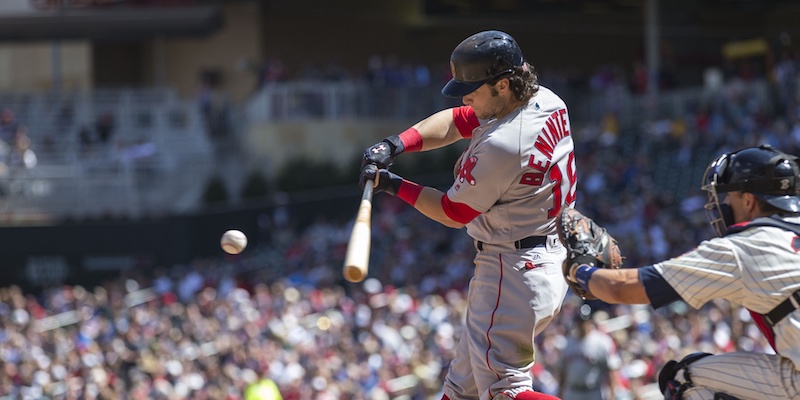Everybody goes through slumps. I should know. I’ve been in one for 41 years. But the best of us break out of them and return to our former glory. That’s where we are now with Andrew Benintendi. As I write this, Benintendi is going through his first slump as a big leaguer. And it’s a bit of a doozy. Benintendi doesn’t have a hit in his last 32 plate appearances spanning seven games. His last hit was a week and a half ago in Milwaukee. That’s bad, or at least it isn’t good. But this is Andrew Benintendi, first round draft pick and Red Sox system rocketeer. He’ll break out and be the guy he was last year and earlier this season again. He’ll be alright, right?
The correct answer is: Maybe. Maybe even: Probably. But still: We don’t know. Which in a way is good because otherwise this article would be over now and I’d have to come up with something else to write about. Fortunately for me: We still don’t know! But we can guess and we can do even better than that: We can guess in an educated manner.
Sometimes slumps look different. I recall Xander Bogaerts in his rookie season chasing everything off the plate. You could see the slider off the plate coming and you knew he’d give one of those half-hearted weak swings, the kind where the batter himself is actively thinking, “Why am I doing this?” But if you watch Benintendi during his slump, it’s not like that. At least it’s not like that yet. He’s still making contact, not striking out at any increased rate, even. In fact, if you break it out by months, May has seen Benintendi cut his strikeout rate by over three percent and up his walk rate by almost four percent. Which is, I think you’ll agree, not something you typically see from someone who is slumping.
Major League Baseball publishes exit velocity for batted balls in play and Benintendi’s 50 batted ball rolling average exit velocity has only dropped ever so slightly of late. It’s gone from about 90 mph on average to about 88 mph. That’s not nothing, but it’s not the reason you went from a .900 OPS to 0-for 30 either. Fangraphs publishes exit velocity as well, though they do it in three buckets, soft, medium, and hard. Before Benintendi’s slump began, we’ll say from the beginning of the season until May 9 when he had three hits against the Brewers, 86 percent of his balls in play were either medium or hard. That’s five percent above the league average. Since May 10th though, that number (hard plus medium) has fallen to 78.3 percent, or below average.
More germane maybe is that his soft hits have gone from 14 percent to 22 percent. What has also happened is Benintendi’s hit types have changed. He’s gone from hitting line drives 22 percent of the time to hitting line drives four percent of the time. What that’s meant in practice is few guaranteed singles or doubles. In place of line drives, Benintendi has been hitting more ground balls (and a few more fly balls).
To sum up, Benintendi isn’t striking out more, but he is making weaker contact, and contact that is less conducive to getting hits. Also, this has happened over a very small stretch of time. It’s entirely possible that Benintendi is under the weather, has a minor nagging injury, or some other such thing that is making his best possible performance more difficult. We can’t know why his batted ball profile has changed, just that it has and, this being a bit under two weeks, that it could change back just as quickly.
A lost season for Benintendi would be far from a good outcome, but we’re not there yet. So far he’s only had a bad couple weeks. In a normal season for an above average player, two bad weeks barely registers.
The player Benintendi is repeatedly compared to is Michael Conforto of the Mets. Both are young outfielders, first round picks, who made it up to the big leagues very quickly. In Conforto’s case, he was drafted in June of 2014 and was in the majors by July the following year. Benintendi took a month longer, but took essentially the same path, jumping directly from Double-A. And now for the bad news and then the good news. The bad news is Conforto struggled for almost his entire rookie season. The good news is, so far in this, his second season, he’s hit like the star the Mets thought he was last season. Sometimes there’s an adjustment period required for a young player, especially one who barely spent time in the minor leagues. When that adjustment period has to take place at the major league level and the growing pains the player experiences are hurting the major league team instead of say, the Double-A team, the fans and sometimes even the organization can be quick to dump on the player. That was the case with Conforto.
But even in that worst case scenario that Conforto went through, he has emerged as the star player he was thought to be last season. A lost season for Benintendi would be far from a good outcome, but we’re not there yet. So far he’s only had a bad couple weeks. In a normal season for an above average player, two bad weeks barely registers. Last year Mike Trout, had a two week stretch where he hit .220/.333/.340.
So, watch Benintendi’s performance going forward for line drives, watch to see if he keeps his low strikeout rate, watch to see how he handles his first bit of major league stress. These will the indicators of his slump, and how we’ll know he’s out of it. That and dingers. If he hits lots of dingers, we’ll know then too.
Photo by Jesse Johnson – USA TODAY Sports
